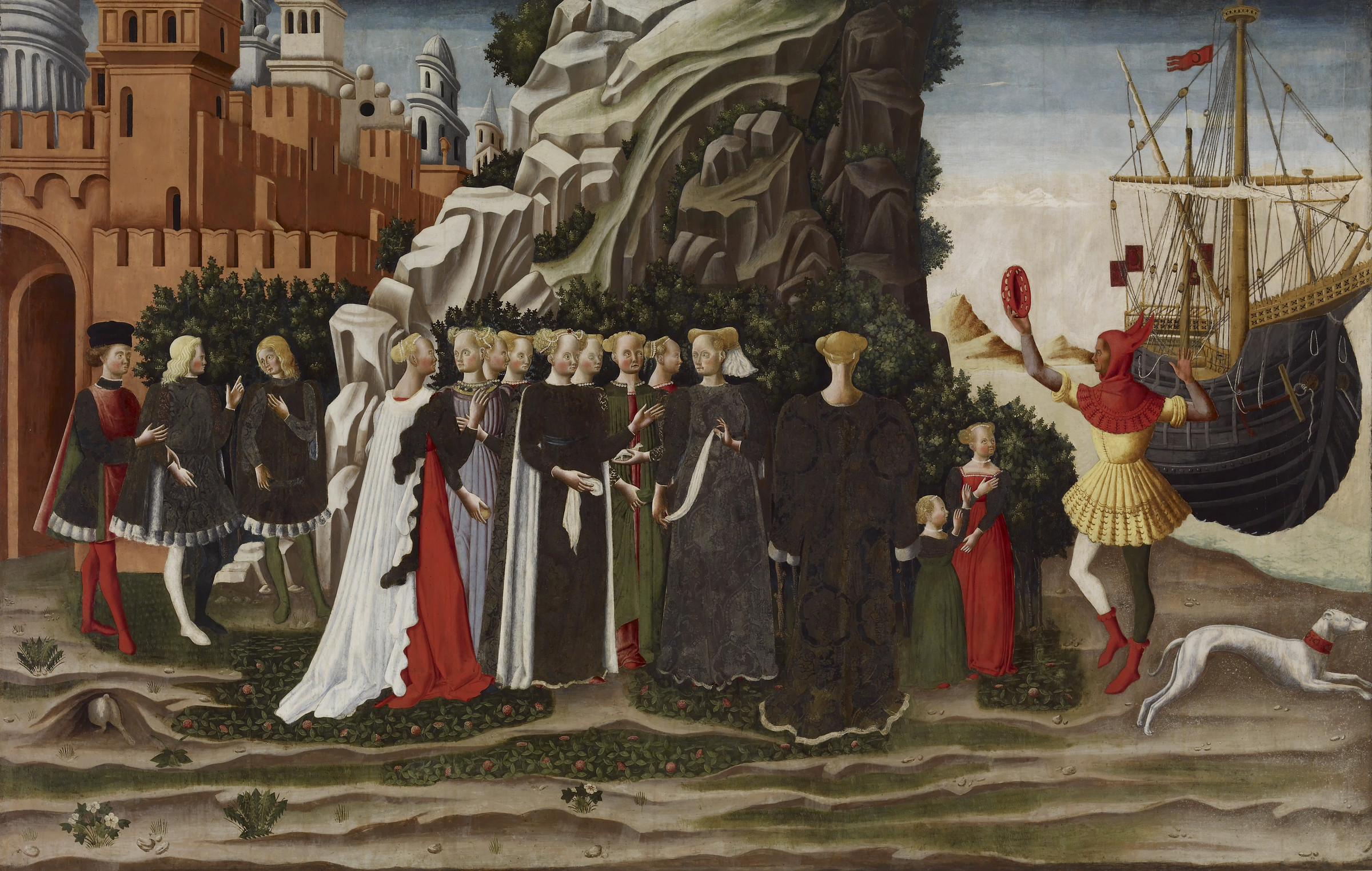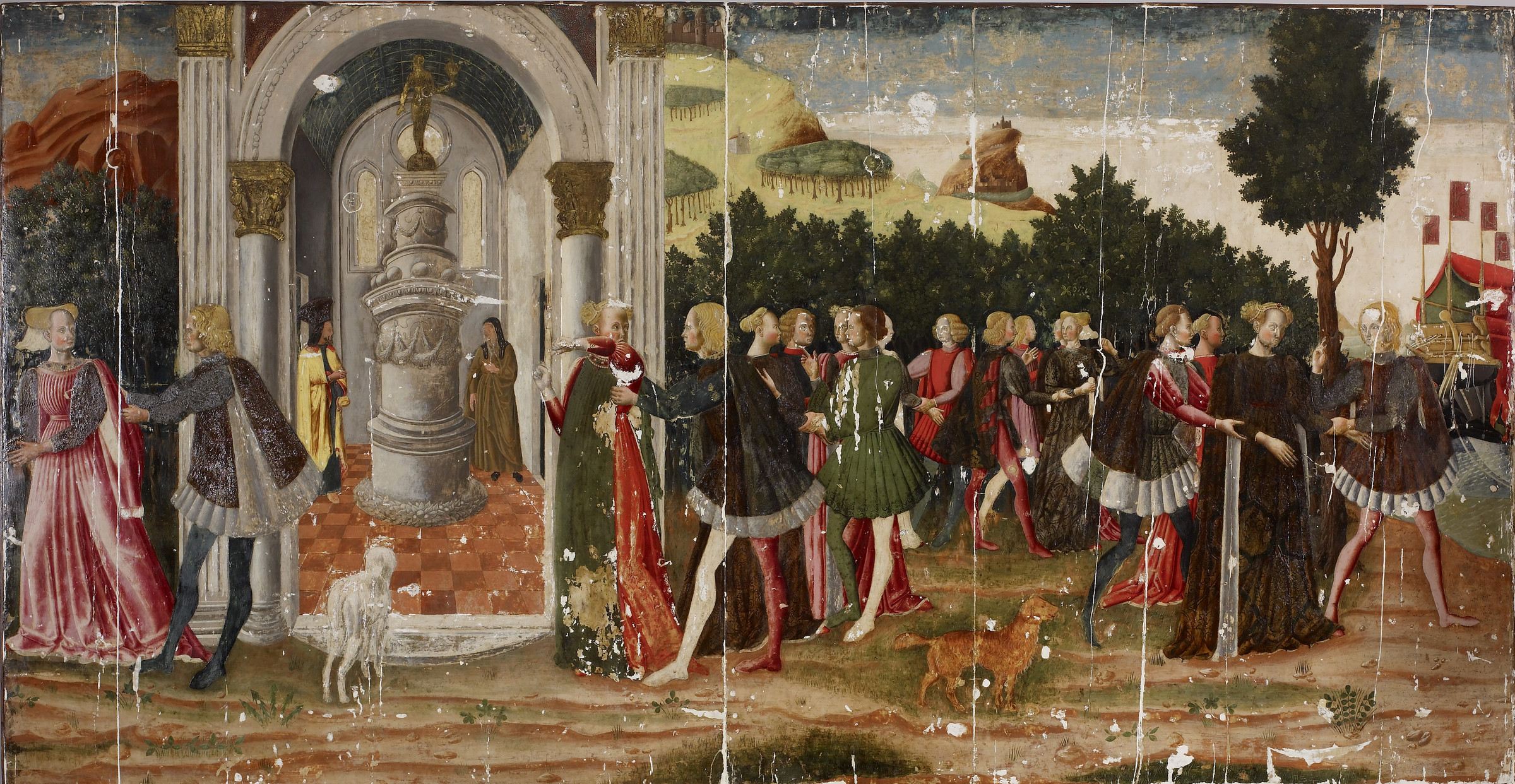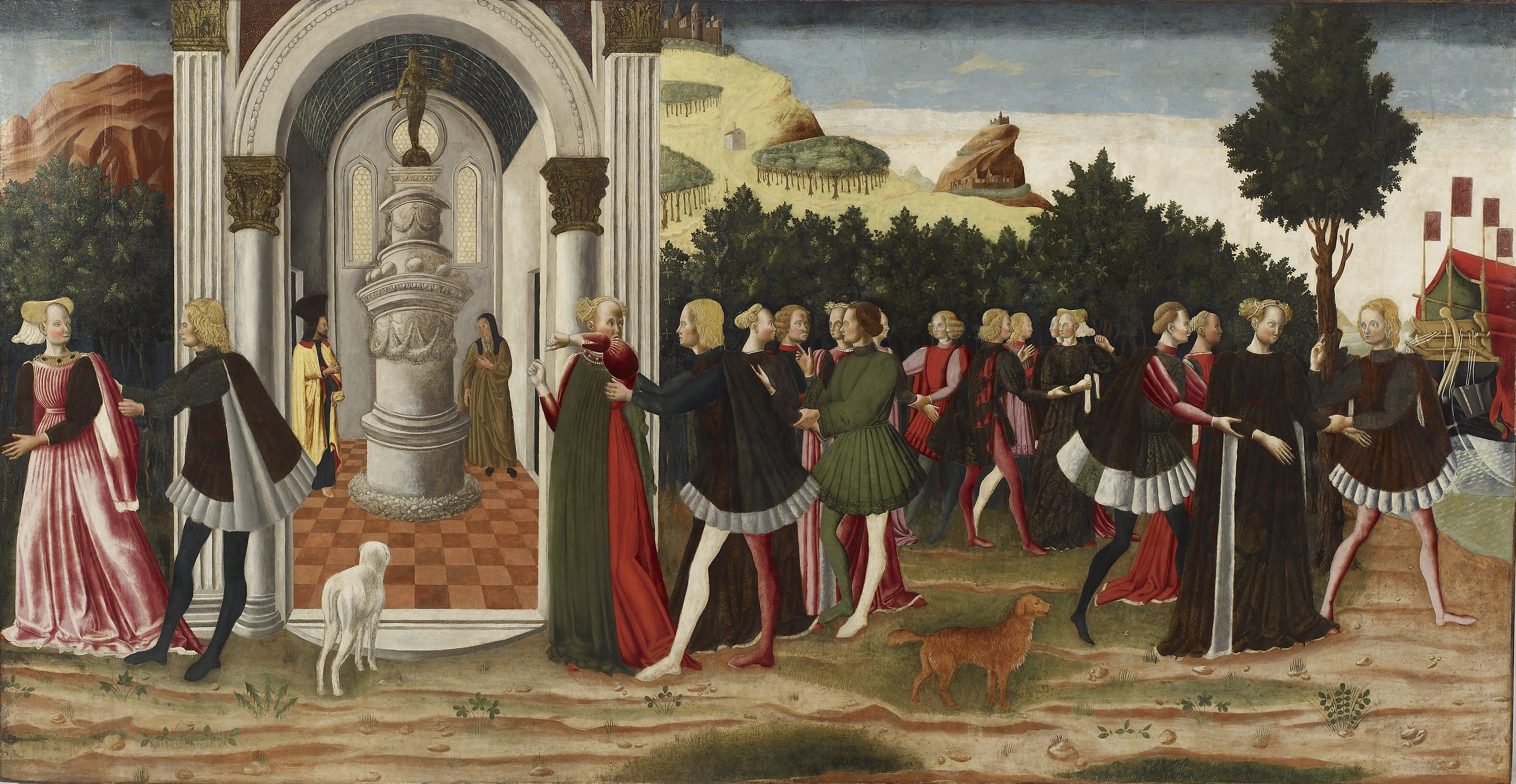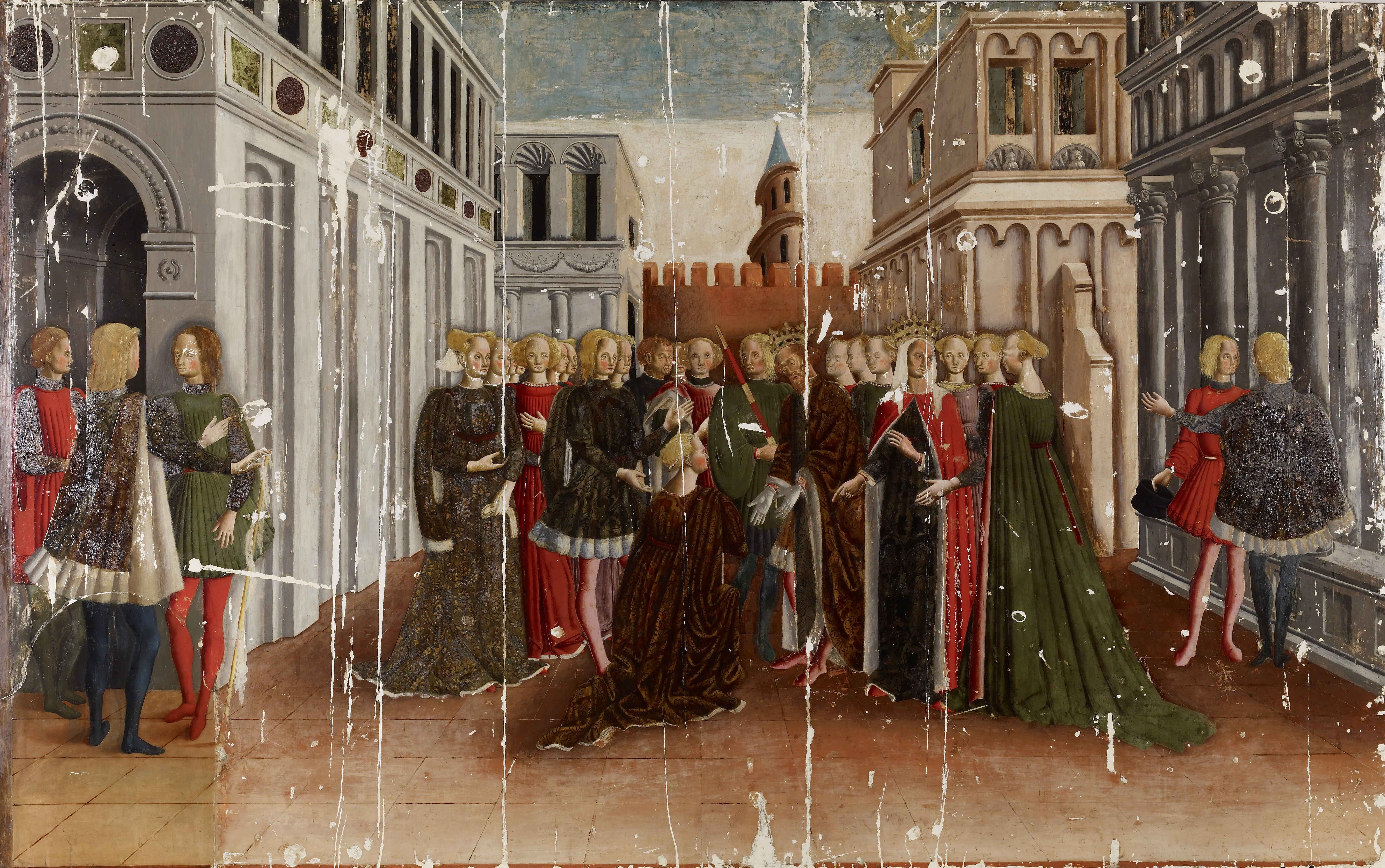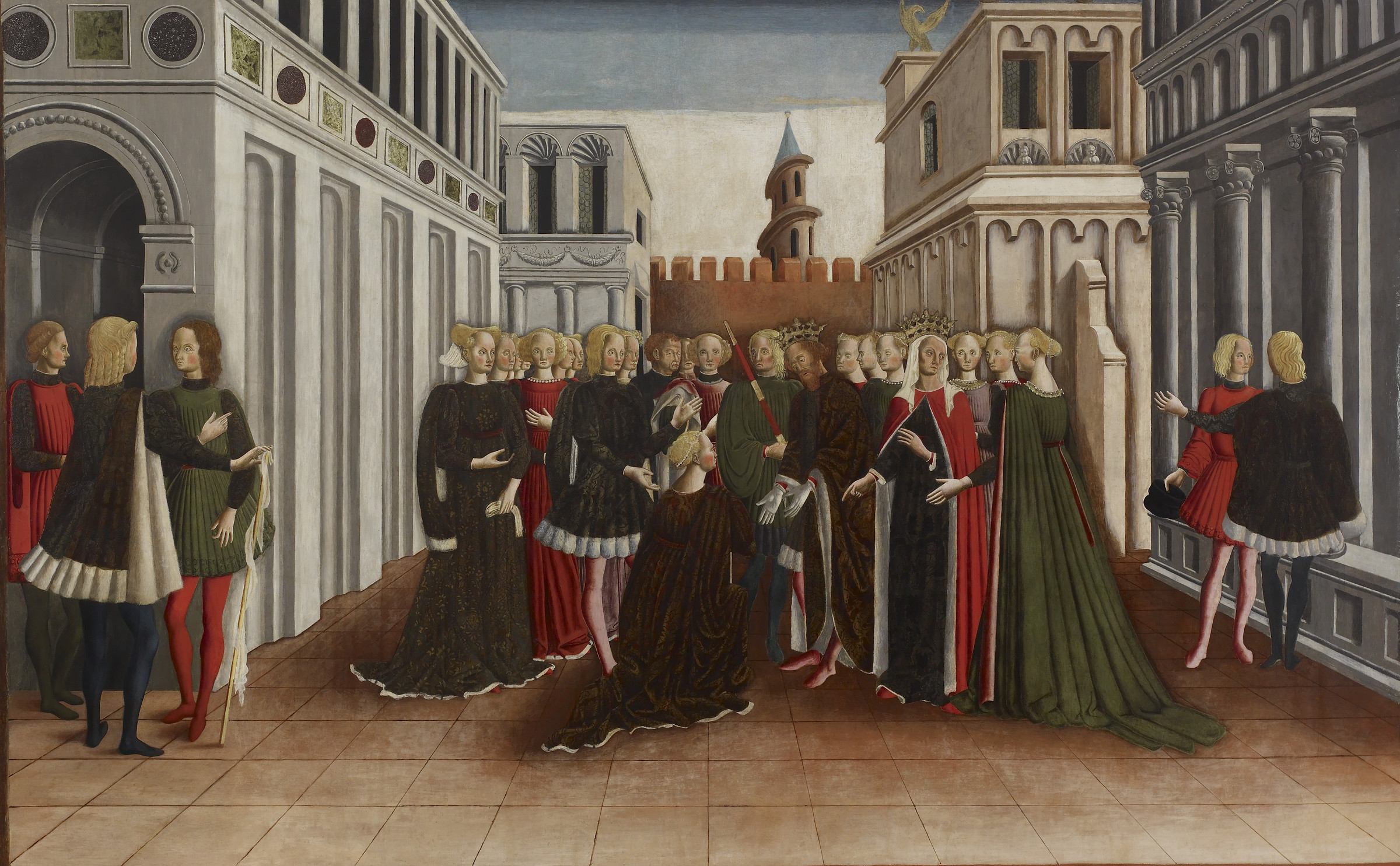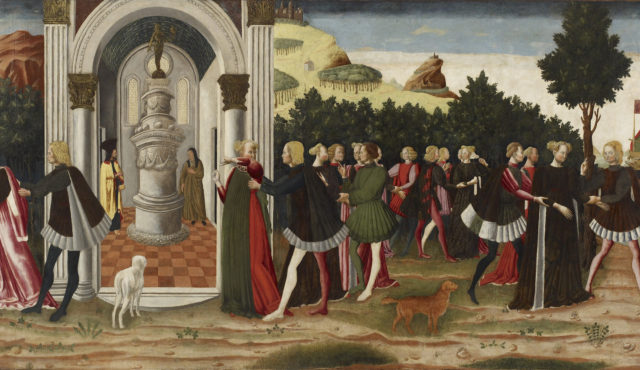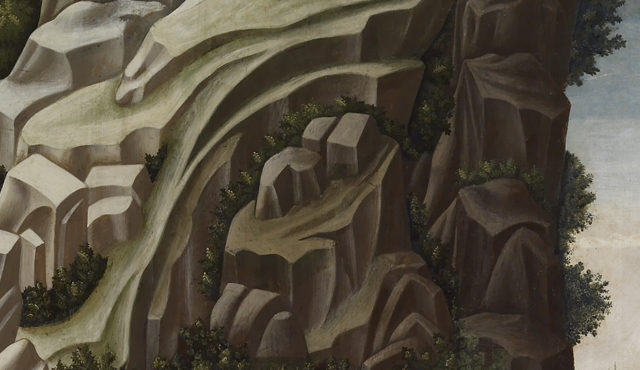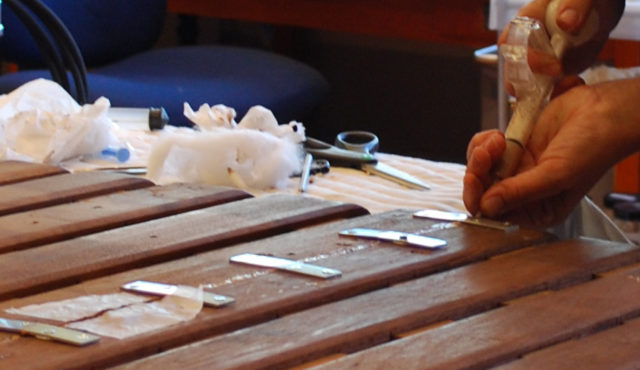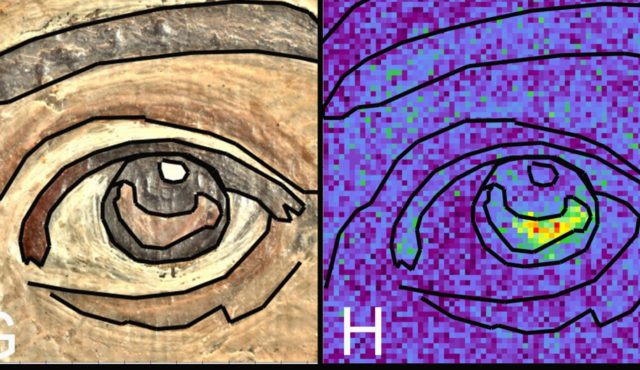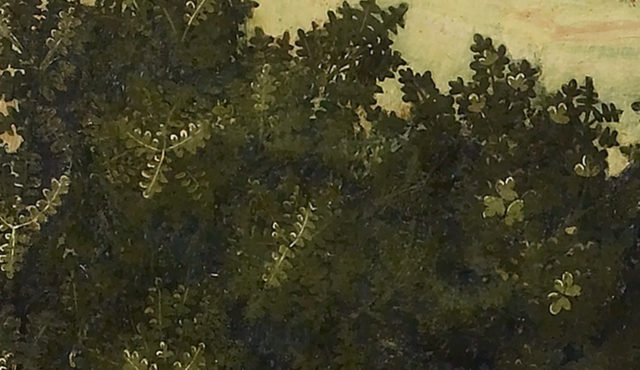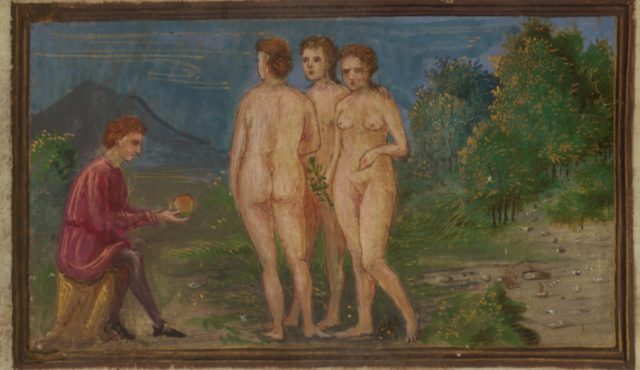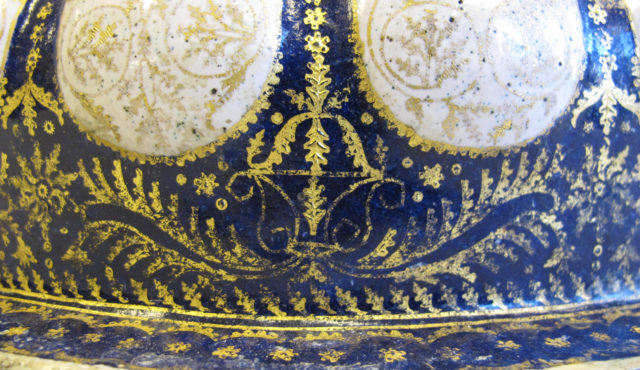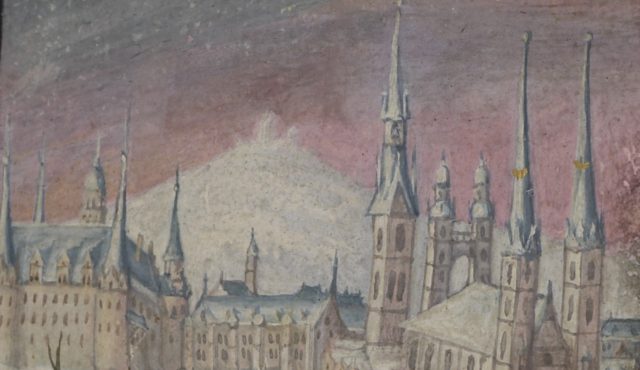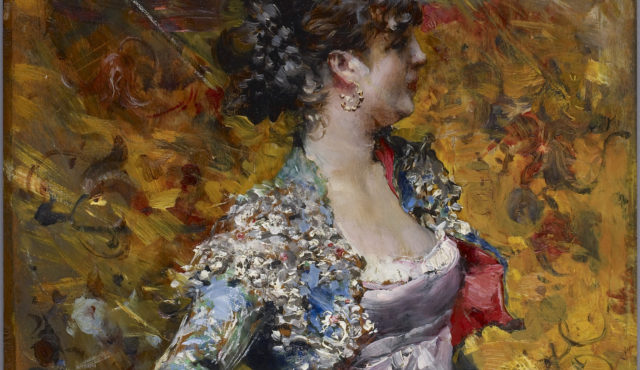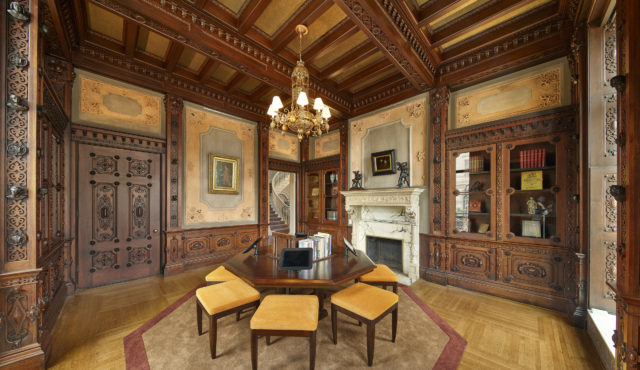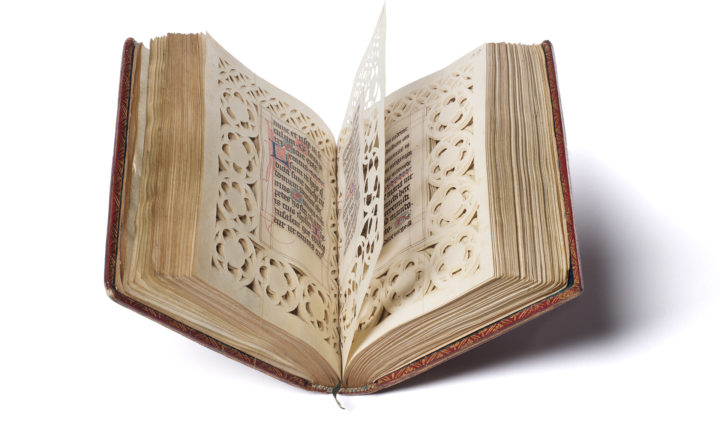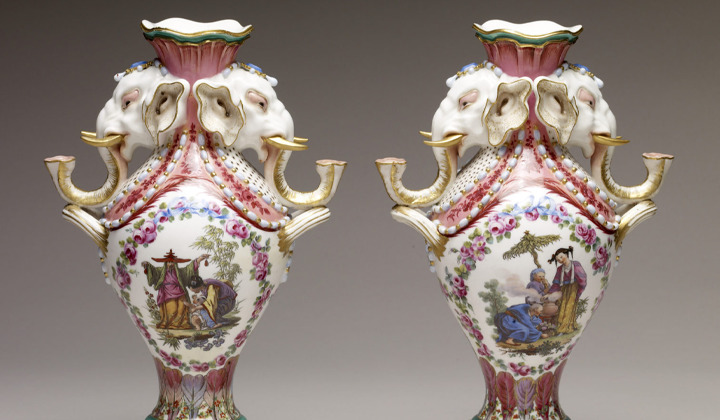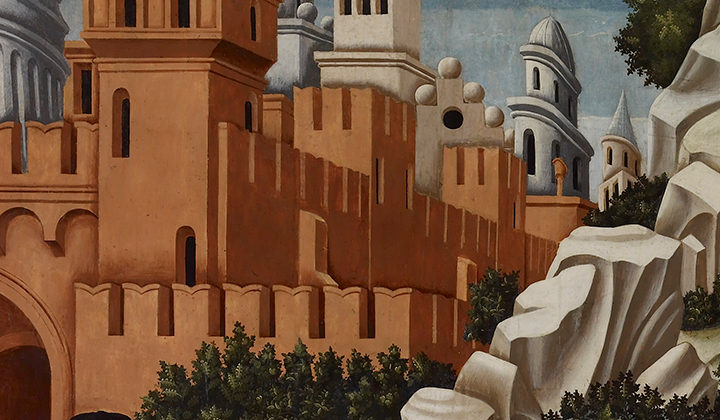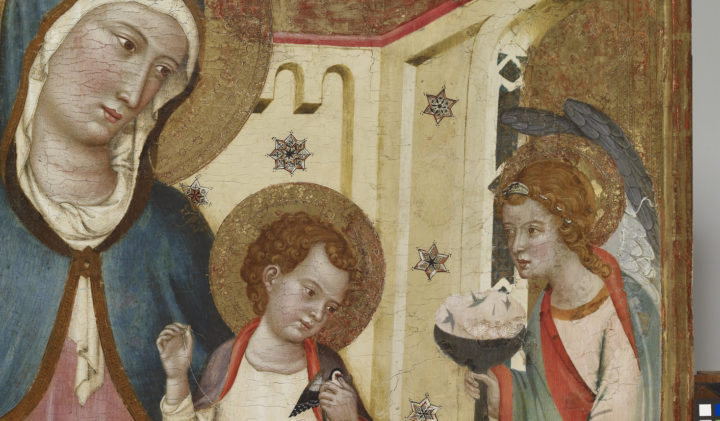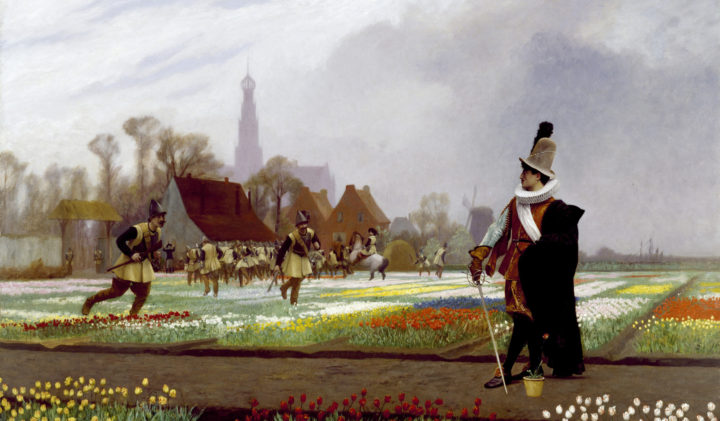Like most centuries-old works of art, the Walters’ monumental Abduction of Helen series, comprising The Departure of Helen and Her Entourage for Cythera, The Abduction of Helen from Cythera, and The Reception of Helen at Troy (fig. 1), suffered from the passage of time. Because of their unusually large size, and perhaps because they were not painted by a more widely recognized (and therefore revered) artist, the paintings seem to have suffered more than typical panel paintings from the period. By the time they arrived in Henry Walters’ collection in 1915, the panels had been thinned, cradled, and trimmed, and had warped and split. Varnishes had darkened and had been removed with harsh cleaning methods that abraded the paint layers; large and small areas of paint and gilding had flaked off; and the originally sparkling gold and silver finishes of the applied brocade, or Pressbrokat, intended to simulate luxury fabrics, had dimmed or been overpainted.[1] The restorations undertaken before Walters acquired the paintings exacerbated some of the damage they were intended to remedy. These early campaigns were carried out using state-of-the-art contemporary materials and methods, but hindsight has proved that these efforts often did more harm than good. This essay surveys, on the basis of what can be gleaned from present evidence, the restoration of the panels prior to their acquisition by Henry Walters and describes the conservation of the three paintings carried out between 2010 and 2017 by conservators at the Walters Art Museum.
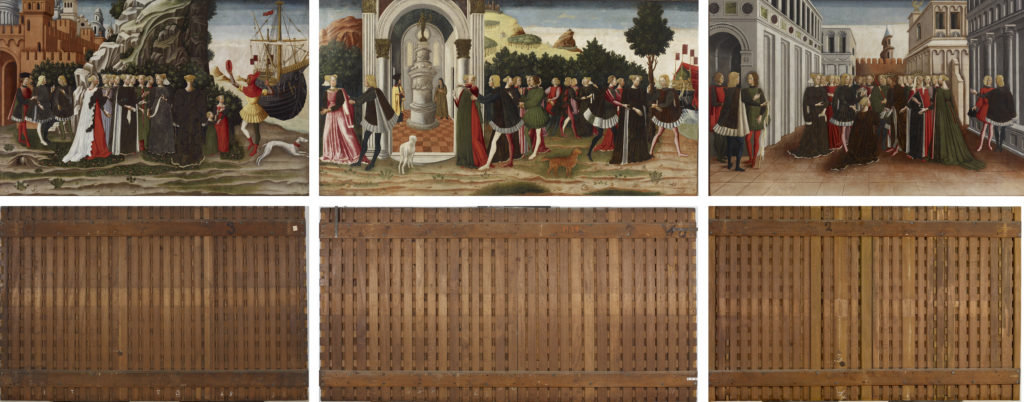
Front and back (showing cradle) of Dario di Giovanni (ca. 1420–before 1498) and collaborators, The Abduction of Helen spalliere. Tempera and Pressbrokat on spruce. The Walters Art Museum, Baltimore, bequest of Henry Walters, 1931. Left: The Departure of Helen and Her Entourage for Cythera, 60 × 94 3/16 in. (152.4 × 239.2 cm), acc. no. 37.1178; center: The Abduction of Helen from Cythera, 60 3/8 × 116 1/4 in. (153.3 × 295.3 cm), acc. no. 37.1179; right: The Reception of Helen at Troy, 60 1/16 × 96 1/8 in. (152.6 × 244.2 cm), acc. no. 37.1180
The Paintings’ Wooden Supports: Past Treatments
Wood has been used as a painting support for centuries due to its portability, its strength, and its nearly ubiquitous availability. Concurrent with this use have been attempts to control the tendency of wood to absorb and release moisture and to warp under certain conditions, resulting in damage to the more brittle paint layers. Recent conservative methods of treatment, guided by ethical principles and benefiting from scientific advances and modern climate controls, have replaced the more radical restorations of the past, in which an aesthetic to keep paintings flat was often more highly valued than the paintings’ overall preservation. Until the mid-twentieth century, panel supports were not considered integral parts of the paintings; therefore substantial parts of the wood were often removed in the effort to flatten the paintings.
Before Henry Walters acquired the three paintings, the panels on which they were painted had been thinned excessively by planing down the wood on the back from an original thickness of approximately 1–1 1/2 inches (25.4–38 mm), estimated on the basis of surviving unthinned large-scale panels, to between 3/16 and 7/16 inch (4.7–11.1 mm). Removal of some original wood from the back of a painting was necessary to obtain a sufficiently flat surface to attach a cradle: a rigid grid system composed of wooden battens adhered to the reverse of a panel parallel to the grain of the wood, through which sliding wooden cross-grain bars are inserted (fig. 1). Though their use is now discredited, restorers frequently applied cradles to panel paintings to provide restraint in order to counteract the natural tendencies of wood to warp. Since it was easier to flatten thinner panels than thick panels, supports were often excessively thinned when paintings were cradled (fig. 2).
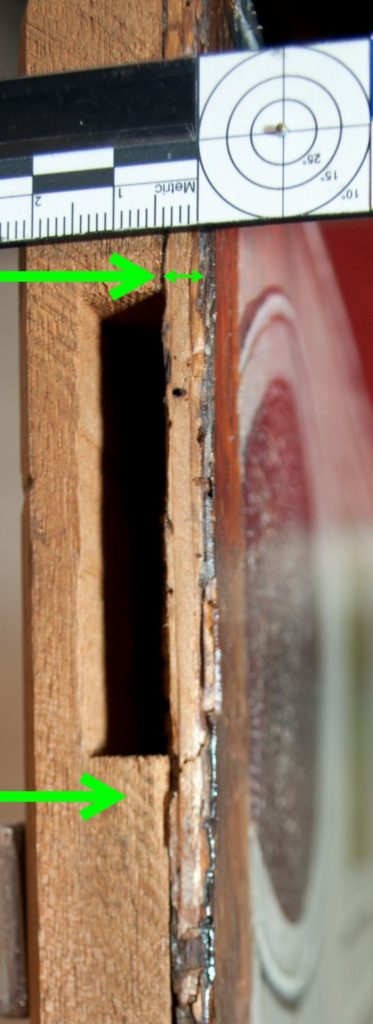
Fig. 2
Side view detail of a thinned spalliere panel: Original panel (arrow at top) and cradle (arrow at bottom)
This structural treatment compromised the Walters spalliere because of the panels’ size, weight, and proportionately extreme thinness after cradling. When the newly exposed wood on the backs of the three paintings was subjected to atmospheric fluctuations, new tensions resulted in splits and warpage, causing the sliding cross-bars to lock in place and provoking further splits in the panels.
The tops and bottoms of the vertical cradle battens were chamfered to the panel edges and the sides beveled to make the cradles less visible from the front. The two vertical battens at the outermost edges of each of the paintings were constructed solid with carved slots down their inner edges to accommodate the horizontal cross-bars, which are almost one inch shorter than the paintings’ widths to allow them room to slide. This “closed-edge” cradle variation was probably undertaken to strengthen the sides of these very large, excessively thinned panels.
Tool marks left by thinning with a hand plane are evident on the backs of the panels in the spaces between the cross-bars and battens. Because of the paintings’ large size, the panels, each composed of five or six planks butt-joined (joined side to side), had been divided into smaller sections at some of the original joints in order to facilitate the attachment of the cradles; it is not possible to determine whether they were planed down before or after their separation, though the latter is more likely. The sides of the planks at each opened joint seem to have been slightly planed, removing fractions of the painted image. This was probably done to create two smooth, clean edges for re-gluing, but at some joints it resulted in a slight misalignment of the painted scenes.
The Departure and the Reception, the smaller panels, had each been separated and cradled in three vertical sections then glued together again to re-form each painting. Four metal pins had been inserted into the cradled panel sections on either side of each joint, spaced along the length, to align and strengthen the component sections. A segmented V-shaped vertical wooden strip had been adhered to further reinforce the backs of these two joints on each panel; the two long sides conformed to the triangular space created by the beveled edges of the battens (fig. 3).
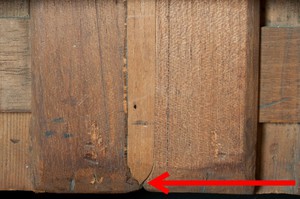
Fig. 3
Detail of cradle of the Departure, showing V-shaped wedge glued to vertical bevels
The Abduction, the largest painting of the series, was cradled in two large sections rather than three.[2] It was separated along the joint near the panel’s center and then re-glued without V-shaped wooden strips, but with four metal pins spaced along the length of the glue joint.[3] This resulted in a wide, extremely fragile support that subsequently required another attempt to stabilize the panels by adding to each three large horizontal wooden battens (approximately 5 1/8 inches wide by 7/8 inch thick [130 × 3 mm]) that were screwed cross-grain into the vertical battens across the width of each painting near the top, middle, and bottom, to prevent the excessively thinned panels from flexing.
All three panels had been damaged by wood worm larvae. Exit holes are visible along the four sides of each panel, and the interiors of several worm tunnels are exposed on the backs, indicating that they existed before the panels were thinned. (There is no evidence of worm holes on the painted surfaces.) The trimming of some parts of the paintings might have been due to significant localized insect damage. The Departure retains original unpainted wooden margins on both the left and right sides; one unpainted margin remains on the left edge of the Reception. All other edges have been trimmed, sometimes removing significant parts of the composition (figs. 4 and 5). On the Abduction, strips of wood approximately 1/4 inch wide (6.3 mm) had been attached to all edges, probably to repair damage caused by a saw blade when the panel was trimmed; these were attached at the same time as the cradle, since the attached vertical battens match the extended height and width.
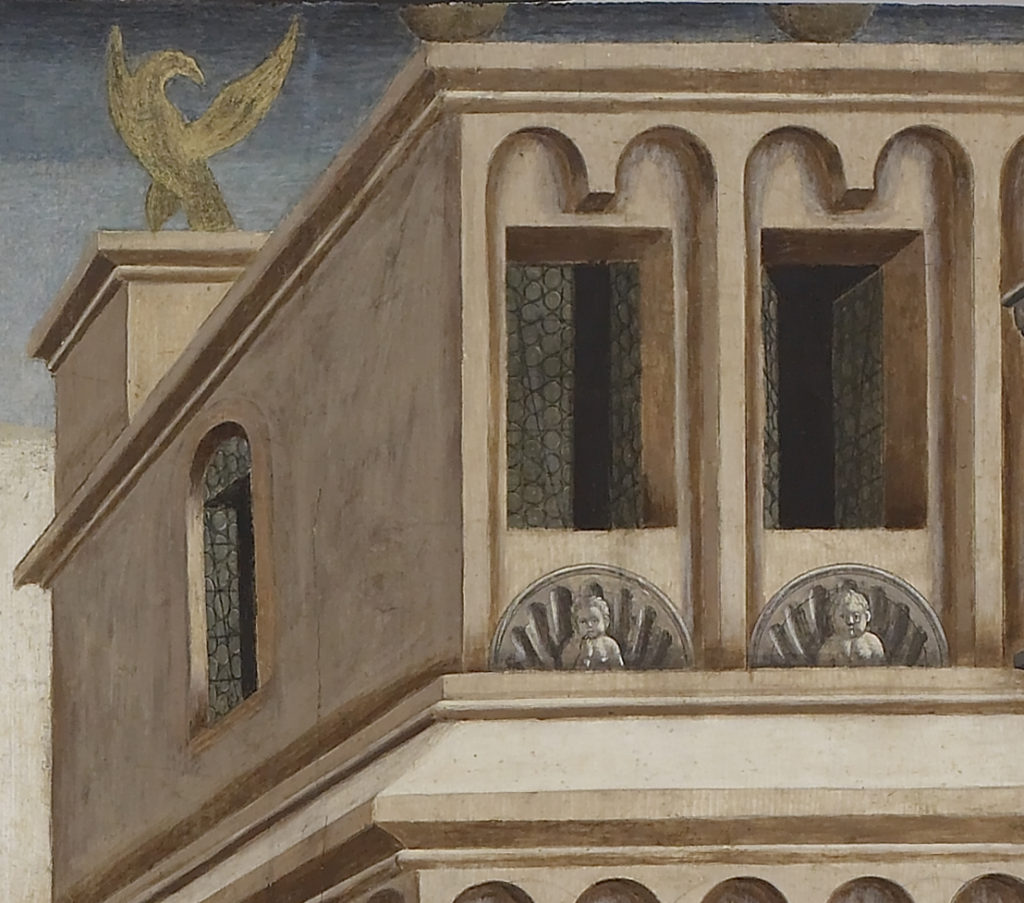
Detail of a building in the Reception, showing cropping of the ornamental stone balls at the painting’s top edge

Detail from the left side of the Abduction showing cropping of the figure’s right hand
Two other structural anomalies on the back of the Reception are related to the thinning and cradling. A large area of wood pulp or sawdust fill is located in the middle of the right side, possibly applied to compensate for damage to the wood during thinning. In addition, an arch-shaped, vertical-grained infill, made from a different wood than the original panel, had been inserted to fill the gap of a cutout (approximately 19 by 15 inches [48 × 38 cm]) that at some point was removed from the painting’s lower left corner. Both the wood pulp fill area and the painted arch-shaped insert had been added prior to the attachment of cradles to the backs of the panels.
As elaborated in Joaneath Spicer’s essay, two similarly large-scale panel paintings associated with the Walters’ spalliere probably originate from the same artist’s studio: A Garden Wall with Trellis of Rosesin a private collection, and The Garden of Love in the National Gallery of Victoria, Melbourne (fig. 6). The Garden of Love was extensively studied by paintings conservator John Payne when he treated the panel at the National Gallery of Victoria, and it shares some interesting similarities with the Walters Reception. The Garden of Love had been thinned and cradled in a similar fashion with wide and flat cradle battens typical of nineteenth-century English cradles (fig. 7), and the painting’s dimensions match those of the Reception by fractions of an inch.[4] The Garden of Love also has an area of wood pulp fill and an arch-shaped cut-out and replacement insert, both of which are mirror images of those on the Walters’ Reception (figs. 8 and 9).
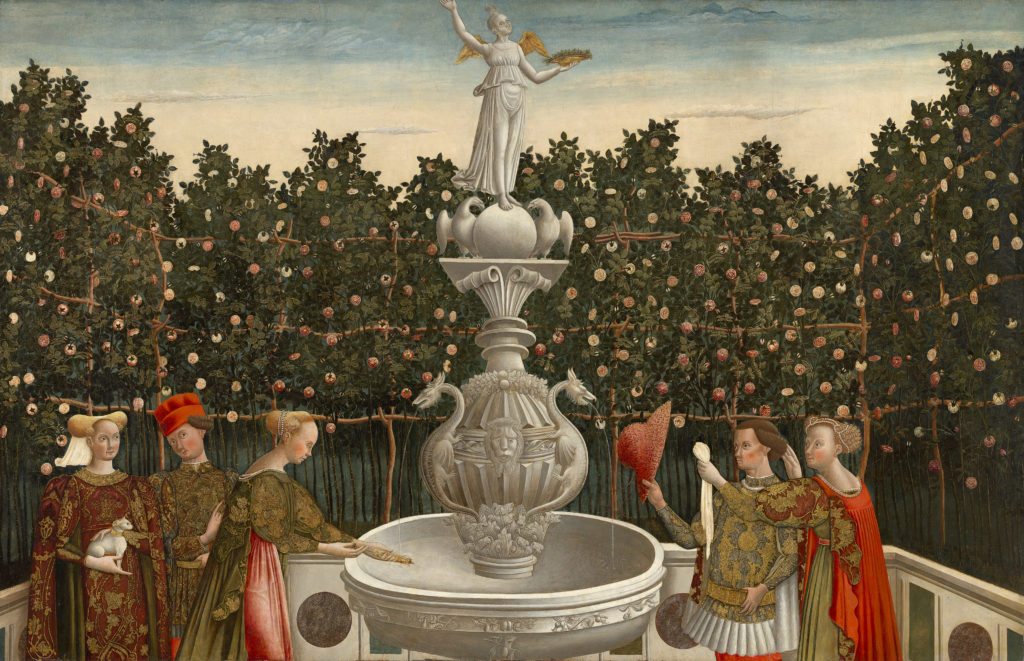
Studio of Antonio Vivarini, ca. 1465–70. The Garden of Love. 60 × 94 in. (152.5 × 239 cm). National Gallery of Victoria, Melbourne, Felton Bequest, 1948, acc. no. 1827/4
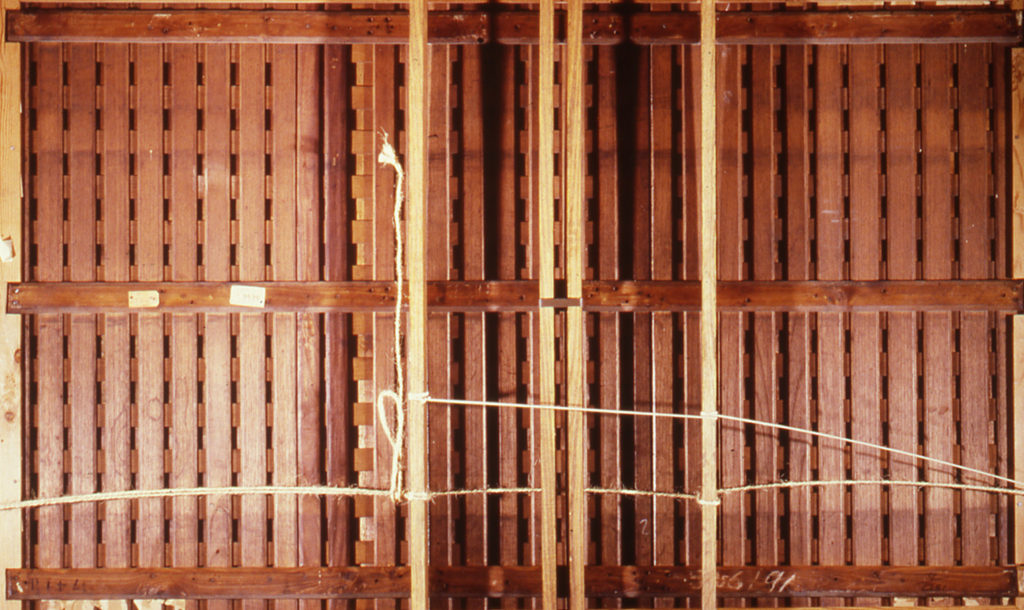
The back of The Garden of Love, showing cradle before it was removed
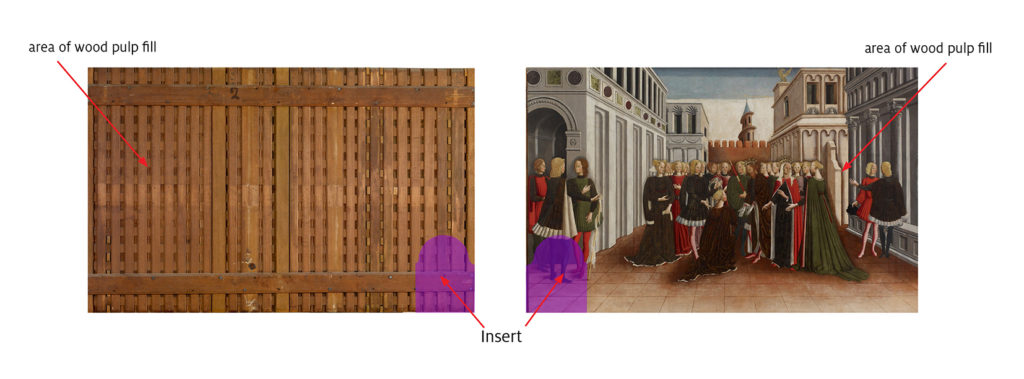
Fig. 8. Back and front of the Reception, showing location of insert and wood pulp fill
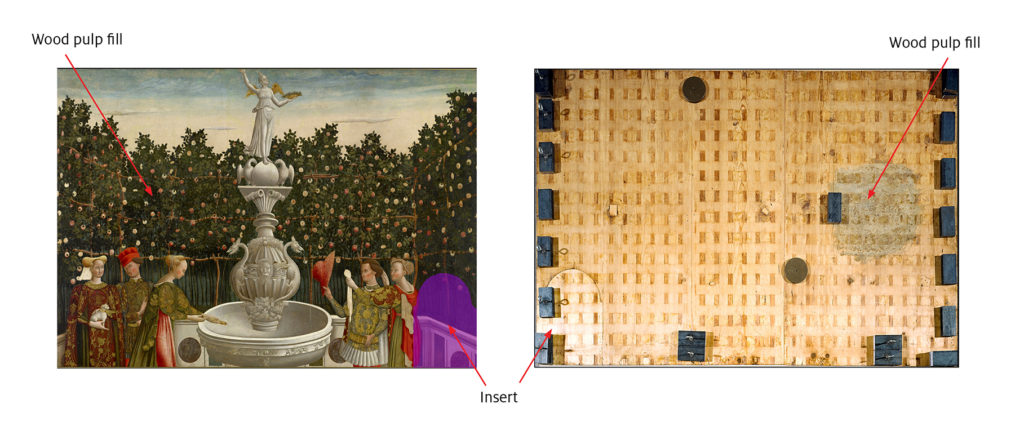
Front and back of The Garden of Love during treatment in the 1990s with cradle removed and weights on the wood, showing location of insert and wood pulp fill
The Garden of Love and the Reception might have hung on two sides of a dividing wall or flanking either side of a doorway, where some type of architectural feature necessitated the removal of an arch-shaped section from each painting. The inserts were necessary to restore the integrity of the two paintings when they were removed from that setting.
X-radiography and infrared reflectography of both paintings revealed brushwork and underdrawing on the main body of the paintings that does not continue onto the inserts, confirming that they are restorations. On the Reception insert, a pentimento, or artist’s correction (now hidden by inpainting), is evident in the legs of the figure with blue tights. The incision lines laying out the floor pattern in the main panel’s foreground of are absent in the insert. X-radiography revealed that an entire sixth figure had been removed on the right from the composition of The Garden of Love; the bottom half was cut out with the arch, and the head and hat that remained were subsequently overpainted.
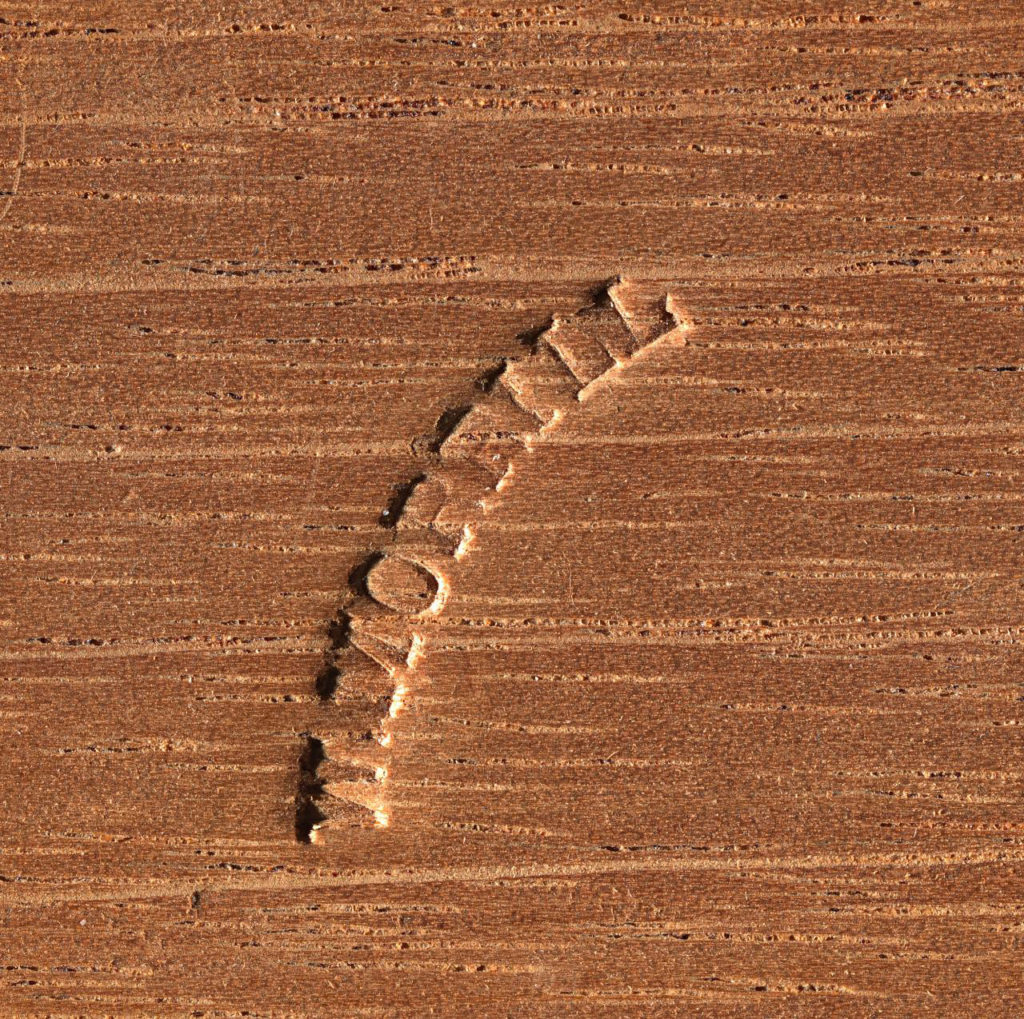
The Garden of Love: W Morrill stamped into wood of cradle
During treatment of Melbourne’s Garden of Love in the early 1990s, the cradle was removed entirely from the back, revealing the name W MORRILL (referring to a family firm of picture liners and panel restorers situated in London) stamped into the wood on the underside of a vertical cradle batten (fig. 10).[5] Similar stamps may be present on the underside of cradle battens on the Walters paintings, but they would only be visible if the cradles were removed. Each of the Walters panels has a round, red wax Italian export seal on the cradle, none of which are completely legible (fig. 11). The seals show a cross within a horseshoe inside a vaguely trefoil form surrounded by a circle with the words “Ufficio per esportazione (des) . . . Firenze” [Office for export (from) Florence].[6] Further research on these export seals might make it possible to date more precisely the purchase and export of the paintings in the early twentieth century.
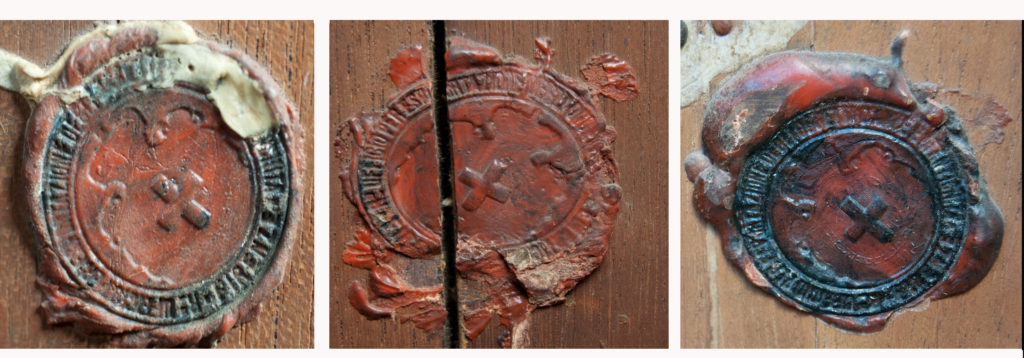
Wax stamps on the cradles of the Departure, Abduction, and Reception.
As the panels split and warped over time, the cradles on the three Walters paintings were further modified. At an unrecorded date, the central horizontal support battens were removed from the cradles, revealing bands of discoloration on the wood of the vertical cradle battens—evidence that this supplementary batten had been present for some time. They were probably removed when the initially closed-edge outer cradle battens had been opened up to relieve tension and allow visual and physical access to the ends of the horizontal cross-bars, some of which were cut but left in place (the cuts are hidden by the vertical cradle battens). This may have been done to release jammed sliding cross-bars (which could have provoked further splits) when most of the others were still mobile. Probably at the same time, four additional vertical battens were added at areas of joints to strengthen the center of the Abduction, and several small wood blocks or “buttons” were glued in rectangular voids between cradle sections, directly behind some major splits, for local reinforcement.
The 2010–2017 Conservation
When treatment began at the Walters in 2010, the supports of the Abduction series had become very unstable and the front surfaces of the paintings exhibited localized undulating warps visible in raking light. Circular plugs located across the upper third of all three paintings, possibly related to their installation or to the addition of bracing battens at an early point in the paintings’ history, had caused telescoping cracks to develop through the ground and paint layers.[7] Over-thinning of the original wooden supports, combined with the weight of the cradles and battens, had provoked additional splits, resulting in associated areas that were no longer in plane and loose. Significant bowing and torqueing occurred during any attempt to handle the paintings, especially when they were laid flat. The cradles were locked, causing stresses throughout the panels; in some areas, only the horizontal cross-battens held the painting together.
One course of action would have been to remove the cradles completely, fix all splits, and apply new secondary supports, but more limited structural panel treatments, intended to stabilize the paintings, were undertaken to allow for a more complete aesthetic treatment.[8]
Structural Stabilization
Structural stabilization secured all moving splits and joints where possible while retaining the cradles. The heavy horizontal battens of the two smaller paintings were carefully removed and replaced with approximately 1-inch-wide U-shaped aluminum channels.[9] To prevent bowing or flexing when the panels are moved, five channels were placed across the length of the paintings, spaced evenly apart from top to bottom, and screwed to the vertical cradle battens. Because of the panels’ warping, the channels did not lie flush to the cradles; to accommodate gaps between the elements of the cradle and the aluminum channels, two different lengths of screws or washers were used to reduce possible further stress on the panels. Washers were also employed to prevent over-tightening. The aluminum channels greatly improved the structural integrity of the supports, especially during handling and moving.
After the paintings’ restorations and fill material had been removed, the splits were repaired with dilute fish glue applied using a small brush or a syringe,working from the smallest splits to the largest.[10] Small bridges and wedges applied during clamping brought the front surfaces back into alignment (fig. 12). A carvable epoxy gap-filler was used when the space between the splits was too wide for a secure glue bond alone.[11]

Mending a split in the Reception with bridges and wedges
The central joint of the Abduction had failed so completely that daylight could be seen through it. The surface was out of plane by approximately 1/8 inch (3 mm), and only the horizontal battens and small metal pins held it together. To realign the two sections, it was necessary to separate them at this joint. To protect overhanging areas of paint and ground, the paint surface was covered locally with a Japanese tissue attached with wheat starch paste along both sides of the joint (fig. 13), and the panels were gradually eased apart with up-and-down motion concurrent with a pulling action. Vestiges of an English-language newspaper were found in isolated areas attached along the inside of the old glue joint, likely residue from newspaper used to protect the paint during past structural treatment. They could be identified as pieces torn from the London Daily Telegraph, but no date could be discerned until prior to the rejoining, when the newspaper fragments were removed and a piece that had been glued face-down revealed the date December 18, 1891 (fig. 14).
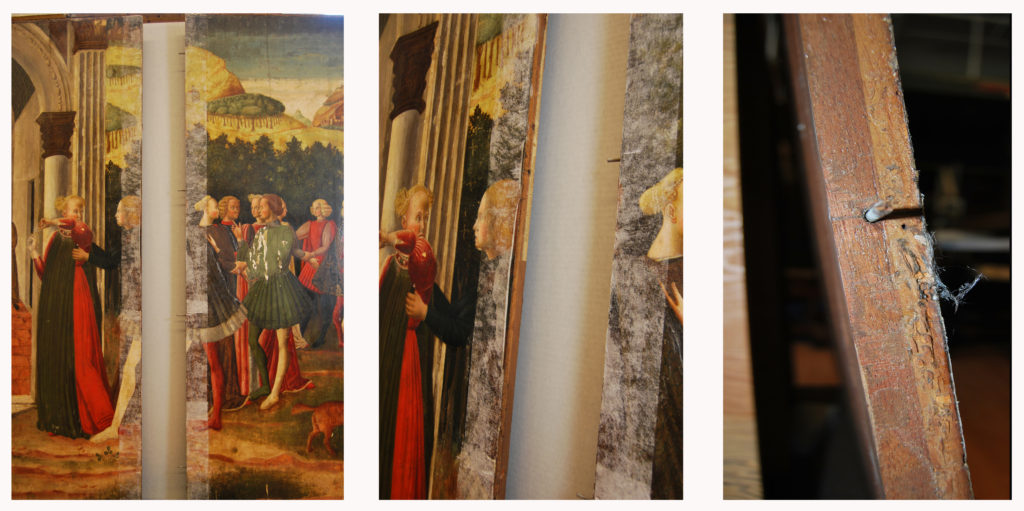
Opened joint of the Abduction, protective facing tissue, and a metal pin
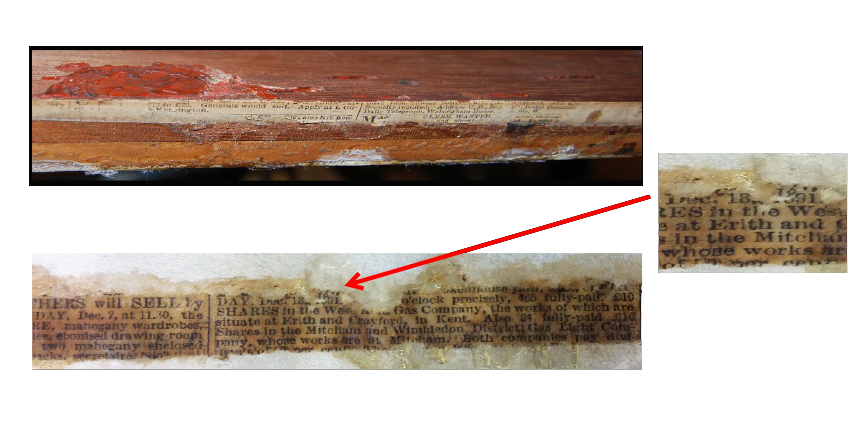
Vestiges of newsprint adhered to Abduction panel joint edge, and after removal showing a date.
If the Walters and the Melbourne panels were cradled at approximately the same time by W. Morrill, then this date suggests a timeframe when the restoration was undertaken either by William Morrill himself (active from 1866 to 1899) or by his son’s company,William Morrill & Son (active from 1900 to 1961), since it is unknown if the same stamp was used by father and son.[12] From the time they were painted in northern Italy in the fifteenth century, there is a large gap in the provenance of the Walters’ paintings until they are documented in a Roman sale in 1905.[13] Although the physical evidence of the English-style cradles and newspaper fragments indicates that the paintings had been shipped to England, where a major structural restoration occurred, there is no record of the paintings traveling there nor any record of their shipment back to Italy. Export evidence from that time might have been removed with the wood during the thinning of the original panel backs. However, since the cradles on the Helen series and that on the Melbourne Garden of Love painting have many similarities, it is likely that all five paintings were cradled by the English restorers W. Morrill. The Melbourne and the private collection garden paintings were probably purchased in Italy in 1887 and shipped to England. The Walters pieces were purchased in Italy in 1905 and came to Baltimore in 1915. This gives an eighteen-year window for cradling the Abduction of Helen spalliere in England with The Garden of Love, and the Daily Telegraph date of 1891 falls within that range.
Rejoining the Separated Panel
In order to rejoin the two panel sections, the metal pins which had begun to corrode and swell were removed and new wooden dowels inserted into the same holes to align the two sections at regluing (fig. 15). The two sections were joined with a customized gap-filling adhesive (composed of Resin W wood adhesive, phenolic microballoons, and coconut flour) designed to rupture at the same joint site if put under major force.[14] The panel was rejoined with the elements suspended across two tables so that both the front and back surfaces were accessible.
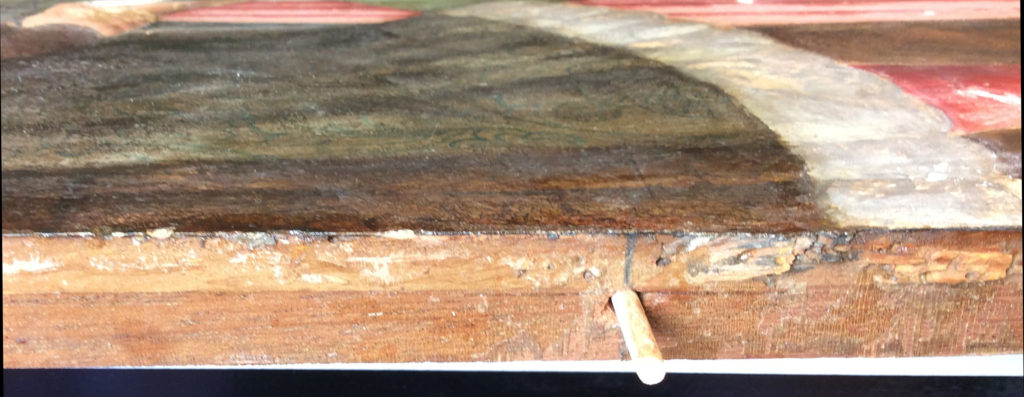
New wooden dowel in an old metal pin hole
Since clamps could not provide sufficient localized force across the large span, the joint was reattached incrementally using small rectangular metal brackets with washers, attached with screws into the vertical cradle battens, to leverage the uneven front surface into a level plane across the two sections. The adhesive was syringed into the joint from the back, where the joint was more open; the wax seal that had split with the joint was covered for protection during rejoining (fig. 16). Once the Abduction was completely rejoined, five U-shaped aluminum channels were attached to the back along the length, spaced down the panel and screwed into the vertical battens at roughly 12-inch (30.4 cm) intervals (fig. 17).
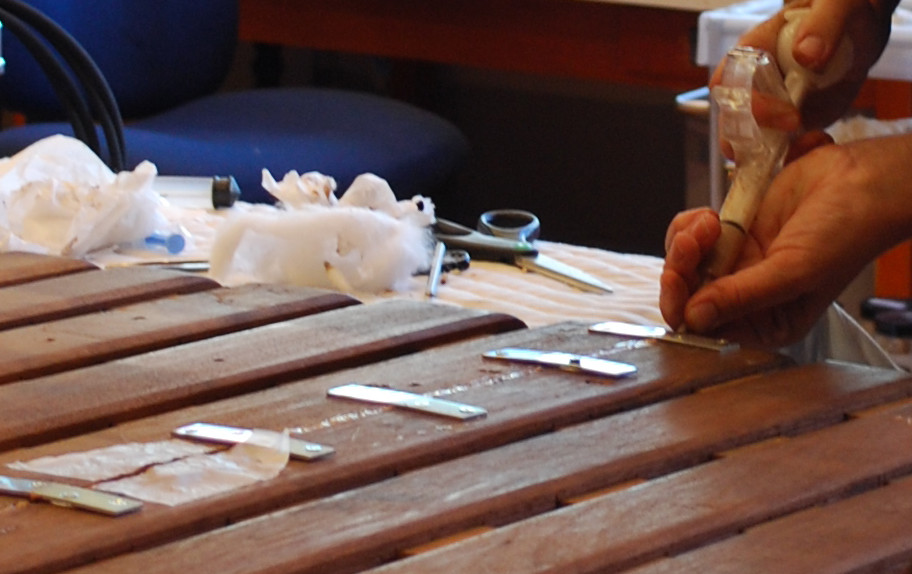
Syringing the gap-filling adhesive into the joint while the panel was aligned with brackets
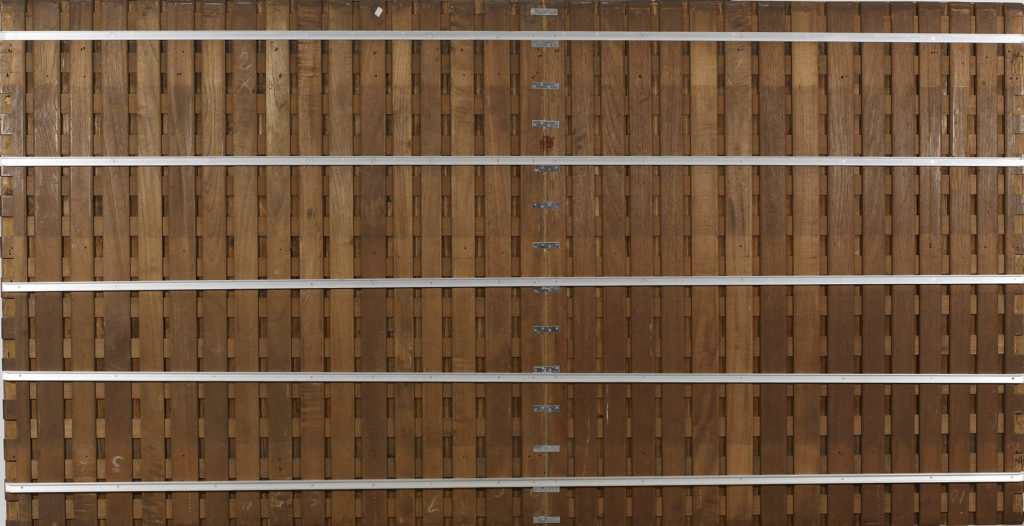
Back of the Abduction panel after structural treatment.
Cleaning, Filling, Retouching, and Varnishing
Before the recent conservation treatment, the three spalliere panels showed scars on their painted surfaces from both generalized damage and a succession of restoration campaigns; each panel looked different than the others because they had been treated at different times. Their early restoration history is unknown, but undoubtedly it entailed the removal of discolored varnishes, filling of losses, retouching, and revarnishing. Over the years, natural resin varnishes, which would have been brushed onto the panels for saturation and protection as a final step, had discolored. Methods for their removal prior to the establishment of professional conservation practices were sometimes harsh and could dissolve or abrade the original paint and textured decoration. To compensate for that damage, losses had been filled with restoration gesso and painted with oil and water-soluble retouching. These were liberally applied not only over splits, abraded paint, and ornamental losses, but also blended onto and over the surrounding undamaged original surface. Historically, it was easier and less time-consuming to blend restorations over the original paint than to fill, retouch, and match localized damages to adjacent areas.
The surfaces were probably cleaned, filled, retouched, and varnished when the panel supports were thinned and cradled in the late nineteenth century. The Reception, with the insert that complements the one found in the Melbourne Garden of Love, had been retouched with oil paints that blended the replacement portion over and onto the original. According to John Payne, The Garden of Love also had numerous losses and areas of abrasion, notably in the Pressbrokat, which was almost completely missing and had subsequently been heavily restored.[15]
The earliest known photographs of the Walters paintings appear in Bernard Berenson’s Venetian Painting in America: The Fifteenth Century (figs. 18, 19 and 20).[16] These black-and-white photographs probably taken around 1915 or 1916, when the panels were acquired by Henry Walters, reveal little about the paintings’ actual condition. Splits and joint separations are evident, but in general each panel looks fairly unified and complete, probably because of liberal overpainting.
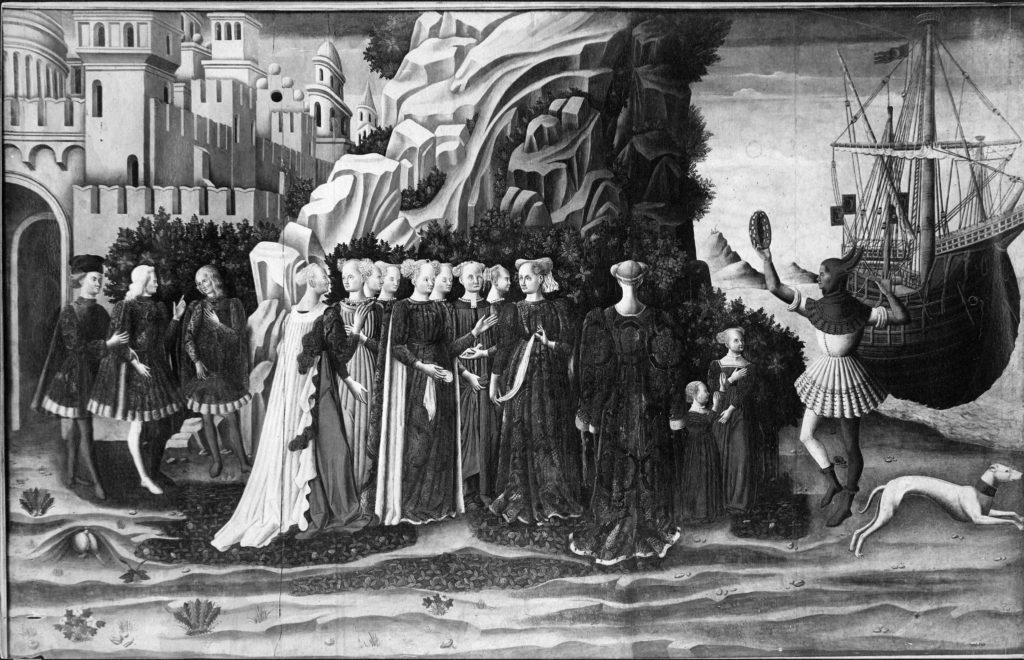
The Departure in 1915–16
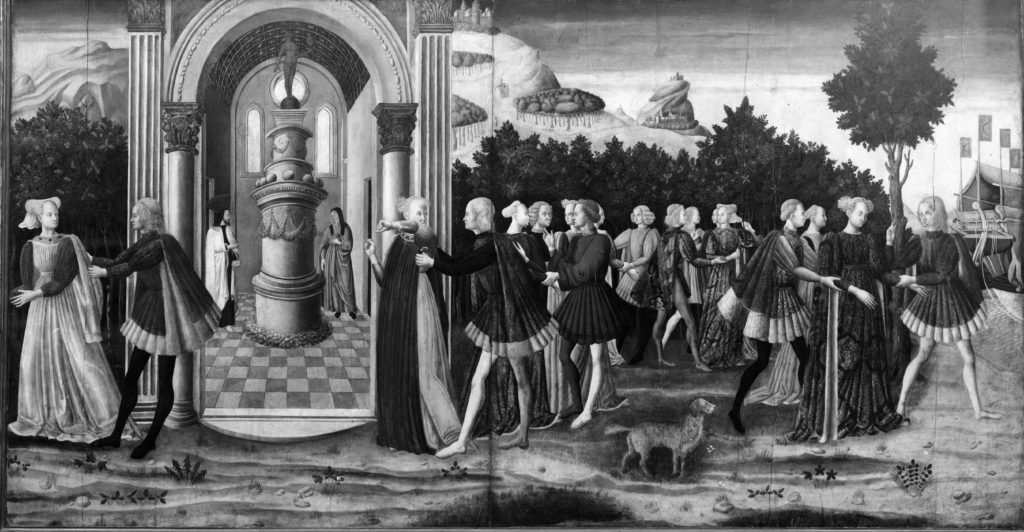
The Abduction in 1915–16
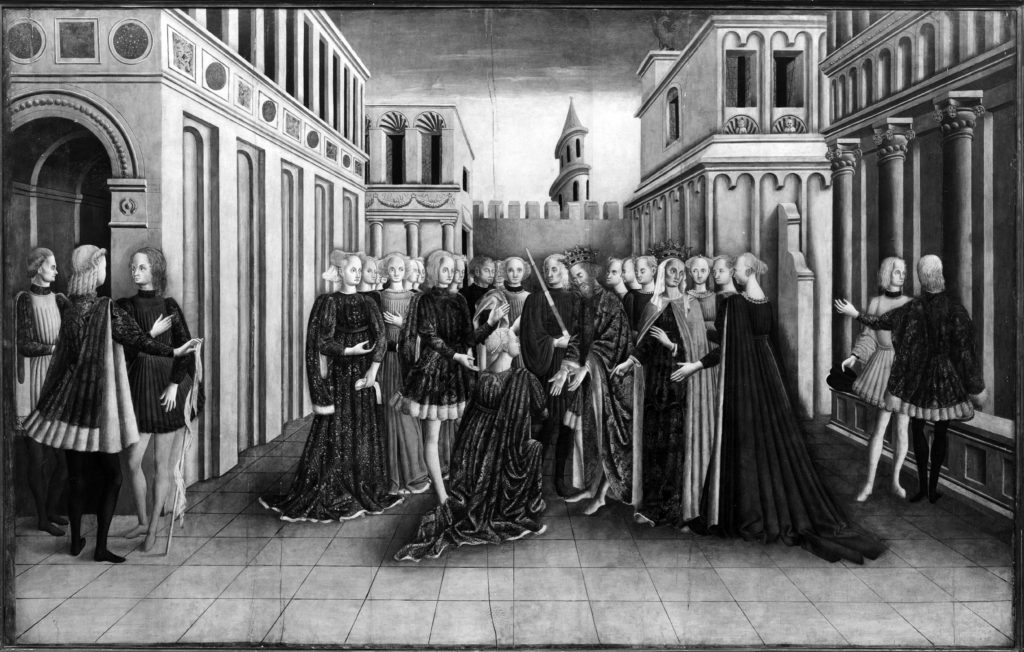
The Reception in 1915–16
The three paintings were individually treated between 1931 (the date of Henry Walters’ bequest of his collection to the city of Baltimore) and the 2010–2017 treatment. A photograph of the Reception prior to its recent treatment gives a sense of what the paintings looked like when Henry Walters acquired them (fig. 21). This panel had not had its varnish removed at the Walters since its acquisition; it was very dark, glossy, and showed no evidence of abrasion or loss. In-house files record a minor treatment in 1974 in preparation for display in the galleries: blisters across the top and bottom and splits were treated with wax to prevent further flaking, surface dirt was removed with mineral spirits, losses were filled with gesso putty and inpainted with watercolors (preferable to oil paint because of their reversibility), and the panel was varnished with a synthetic resin. Thus, at the beginning of the twenty-first century, the painting remained more or less substantially unchanged since 1915. Because the nineteenth-century restoration was so extensive, it was difficult to determine the painting’s actual condition.

The Departure, the Abduction, and the Reception before treatment
The other two panels had been treated at various times between 1934 and 2010. When the recent treatment began, their surfaces were yellowed and displayed darkened, mismatched retouching and bare passages (fig.21). The Departure had been treated at least three times at the Walters. In 1939 “blisters were laid down with glue,” and again in 1948 “blistering paint was treated from the front with wax.” “Darkened varnish and repaint [were] removed with ethyl alcohol, losses [were] filled with gesso and inpainted with tempera, and mastic varnish [was] applied and the surface coated with “special surface wax.”[17] In 1974, blisters and flaking splits were adhered with wax.
The extent of the Departure’s last three restoration campaigns could be determined on the basis of visual examination under reflected and ultraviolet light. The oldest restoration was not discernible under ultraviolet light; it most likely lay beneath the fluorescing layer of natural resin mastic varnish. This campaign, comprising broad passages of discolored or mismatched overpaint, accounts for the majority of restoration paint on the panel. A second campaign of restoration was visible as smaller, faintly dark patches in ultraviolet light, which concentrated mainly over areas of cracks and splits; these appeared to have been applied over the varnish layer. The most recent conservation campaign was likely the dark, non-fluorescing water-soluble retouching, sparingly applied also on top of the varnish. In short, after examination it appeared that the paint layer was in poor to fair condition with extensive loss and abrasion covered in part by multiple campaigns of filling and retouching. The restoration varied in tone and gloss from the original and detracted from its overall appearance.
The Abduction appears to have been first treated at the Walters in 1966, when “blistering of the paint surface which had increased during [the] exhibition ‘Mythology through the Ages’ . . . required that almost the entire painting be infused with wax” (fig. 21). Additionally, the “Surface [was] thinly coated with W & N [Winsor and Newton] varnish and polished with a soft brush.” Nine years later, in 1975, a full treatment was carried out that entailed partial removal of the varnish and old retouching. “Because of the extensive overpainting and very much abraded condition of the original paint surface, the varnish was partially removed. . . . Old fills were leveled. Holes were filled with gesso” and “inpainting of losses was carried out with pigments in PVA AYAB in cellosolve acetate. The painting was then sprayed with AW2 resin in Stoddard solvent.”[18]
For the recent treatment, surface work on the paintings began by removing grime that had accumulated over the years while in storage. This removal was accomplished by rolling swabs with a mild surfactant solution and rinsing with distilled water. Minor areas of scattered flaking paint, mostly along splits in the panels, were consolidated with dilute sturgeon’s glue and when appropriate a small tacking iron with regulated heat control, applied over silicone-release Mylar to gently set down larger flakes standing proud of the surface. Discolored varnishes had to be removed completely in order to reach the extremely darkened retouching, which both hid losses and liberally covered original paint. Synthetic and natural resin coatings were removed with a combination of organic solvents, which additionally dissolved more recent retouching. Older oil retouching required stronger combinations of solvent gels, sometimes with the addition of water regulated to a specific pH. In the end, all overpaint could not be completely removed without disturbing the underlying original paint and ground layers.
Varnish and overpaint removal of all three panels revealed localized as well as general areas that had been seriously damaged by past overcleaning and structural movements of the wood support, such as splits (figs. 22, 23,and 24), especially abraded areas were found in the blue sky, in localized areas of Pressbrokat, and in details outlined in black, such as the round frames in the windows. Faces in particular were often overcleaned, as were areas of gold leaf (fig. 25).

Abraded sky (a) and Pressbrokat (b) in the Abduction, abraded windows in the Reception (c), and abraded faces in the Departure (d)
A number of discoveries were made in the course of the most recent conservation treatment. Cleaning exposed pentimenti, or changes,in the area of the large ship in the Departure. As noted by Pamela Betts and Karen French, x-radiography revealed an entire reorientation of the ship with its bow extending further into the middle of the design, and the rock formation and additional shrubs not reaching as far into the composition (fig. 26).
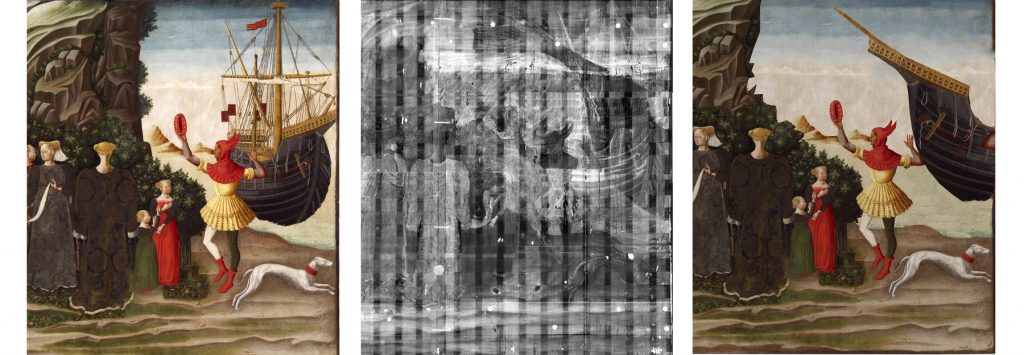
Detail of the Embarkation showing the painting as it looks now (left) compared to the original placement of the ship as seen in an X-ray detail (center) and a digital recreation of the early composition (Hae Min Park)
Overpaint hid a golden apple or ball in one of the maiden’s hands in the Departure as well as an extraordinary surprise in the composition of the Abduction. X-radiography of the panel uncovered a large white form at the foot of the temple of Venus, and as the overpaint was progressively removed, the shape of a dog with its rear legs facing the viewer emerged (fig. 27). While the dog had been abraded from past cleaning, it was by no means lost. Fill material applied during past restorations also liberally covered original paint; the fill was partially removed with a water-based cleaning system and partially removed mechanically with a scalpel (fig. 28).

Detail from the Abduction of old retouching hiding a dog (a), x-radiograph of area (b), during cleaning (c–d) and after treatment (e)
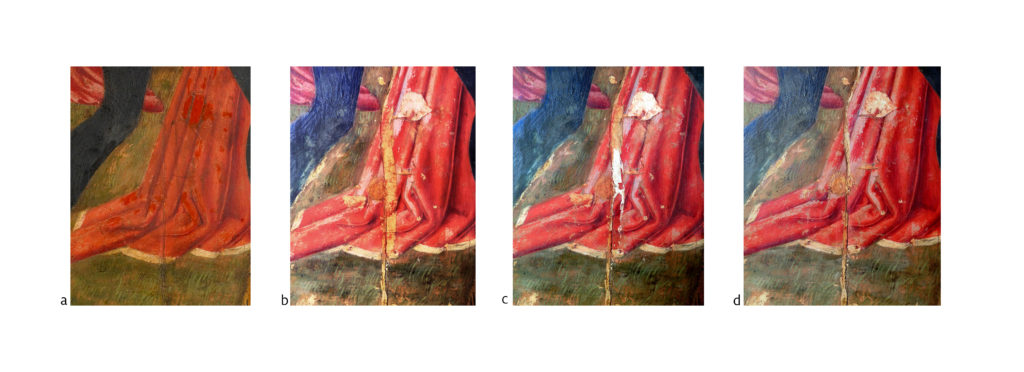
Detail from the Abduction showing removal of overpaint and overfill, revealing original paint
Once old restorations were removed as completely as possible without disturbing the original paint and ground layers, the processes of reintegration began. The areas around losses to the ground layer were locally protected with varnish, then fill material composed of rabbit skin and whiting was applied with a spatula or brush to the level of the rest of the panel. Fills were then textured to match the surrounding surface. The locally applied varnish was removed after filling, then all panels were brushed with an isolating MS2A varnish in mineral spirits as a saturating layer.[19] Inpainting of losses and abrasion was carried out with Gamblin Conservation Colors, and traces of gold leaf were applied as highlights to abraded gilding areas.[20] An imitative retouching technique was chosen as it was apparent how to reintegrate losses from the all the information found in the painting. For example facial features could be transposed from one figure to another with only minor adjustments and abrasion in the sky was reintegrated based upon more solid areas and patterns found in the series. Finally, MS2A varnish with a little wax was sprayed over the entire surface as a protective and saturating coating.
Conclusion
Over the last two centuries, the care and treatment of artworks has shifted from restoration to conservation. In the past, repair and restoration of damaged art tended to involve more intervention with an attempt to present the finished piece as visually undamaged, even if it meant adding excess fill material and retouching over original paint to cover and blend scars and losses, and flattening paintings at any cost. Advances in climate-controlled environments, science, and technology have led to safer and more effective approaches to studying, preserving, and repairing artworks. Modern conservation emphasizes preservation, protection, and documentation, using materials and treatment methods that are both reversible and allow for easier future interventions.
The recent conservation treatment of the spalliere revealed three large damaged panels that had weathered the effects of time and harsh past restoration methods. Earlier attempts to remove discolored varnishes, or restrain the movement of the wooden supports used materials and techniques that though accepted as standard at the time did not age well. The recent conservation treatment has stabilized the panels for the future and revitalized the painted surfaces, bringing them closer to what would have been their original appearance in a fifteenth-century Venetian palace.
Karen French ([email protected]) is a Senior Paintings Conservator at the Walters Art Museum. Eric Gordon ([email protected]) is Head of Paintings Conservation at the Walters Art Museum.
We would like to thank the following people for their contributions to the treatment of these paintings: Megan Berkey, Pam Betts, Lauren Bradley, Daisy DeMarsh, Miranda Dunn, Becca Goodman, Gwen Manthey, Cristina Morilla, Kim Parr, Gillian Quinn and Megan Salazar-Walsh.
[1] For the Pressbrokat, see Betts and Gates in “Dressed in Tin,” in this volume.
[2] Due to the painting’s unusually large size, cradling would have been easier if the painting had been separated into three or even four sections. It might have been separated into two sections so that it could be packed to travel more easily and subsequently be rejoined.
[3]Reopening the joint during the 2010–2017 treatment revealed horizontal lines drawn from the front of the panel to the back of the cradle to mark the locations of the holes for the metal alignment pins, which were inserted in the wooden cradle rather than in the thinned panel.
[4] John Payne believes that The Garden of Love originally had full-length figures and that the painting was substantially cut down. See his essay “Exploring a Fifteenth-Century Garden: A Restoration Uncovers the Past,” Art Bulletin of Victoria 35 (1994): 7–20 at 14–16.
[5] “This long-lived business specialized in structural work. It was begun by Francis Leedham (q.v.) in 1827, moving to 3 Duck Lane in 1839, where it continued until 1980, in the ownership of George Morrill from 1857, and then in the hands of his son, William Morrill, and grandsons.” Jacob Simon, British Picture Restorers, 1600–1950, National Portrait Gallery, London, website resource, 2nd edition 2015.
[6] No date has yet been associated with these export seals.
[7]See Betts and French in this volume.
[8] A full structural treatment would have been invasive and exceedingly time-consuming given the size of each painting. Extensive time was also required for full treatment of the painted surfaces. Knowing that the panels would remain in the Walters’ controlled museum environment, structural treatment of the wooden supports was limited to localized split repair, stabilization, and reinforcement rather than removal of the cradles.
[9] The aluminum channels provide extra strengthening with little additional weight; the wooden battens were retained and catalogued for future reference.
[10] High Tack Fish Glue (Norland Products), extracted from codfish skins, about 45 percent solids.
[11] Araldite AV 1253 (Conservation Support Systems), a carvable, microballon-bulked, two-part epoxy paste.
[12] Simon, British Picture Restorers, 1600–1950.
[13] The painting’s provenance is complicated by its varying attributions. See Joaneath Spicer, [title] in this volume. For the Roman sale, see Federico Zeri, Italian Paintings in the Walters Art Gallery, 2 vols. (Baltimore, 1976), 1:24.
[14] The customized adhesive filler was devised after testing materials recommended in Christina Young, Paul Ackroyd, Roger Hibberd, and Stephen Gritt, The Mechanical Behaviour of Adhesives and Gap Fillers for Re-joining Panel Paintings, National Gallery Technical Bulletin 23 (London, 2002).
[15] Payne, “Exploring a Fifteenth-Century Garden,” 4–5.
[16] Bernard Berenson, Venetian Painting in America: The Fifteenth Century (New York, 1916), figs. 4–6.
[17] Walters Art Gallery, Conservation Examination and Treatment Report, 1948, acc. no. 37.1178.
[18] Walters Art Museum, Conservation Examination and Treatment Report, 2011, acc. no. 37.1179.
[19] MS2A varnish is a modified polycyclohexanone resin with a low residual ketone content.
[20] Gamblin Conservation Colors are retouching colors made from Laropal A-81 (urea-aldehyde resin), mineral spirits, and lightfast pigments.

